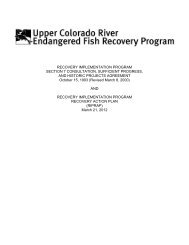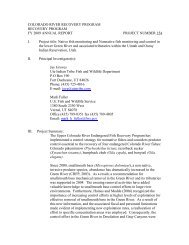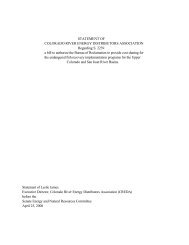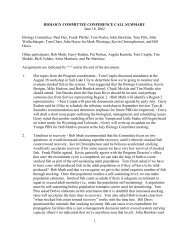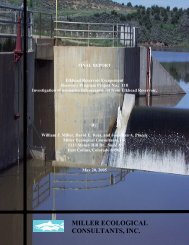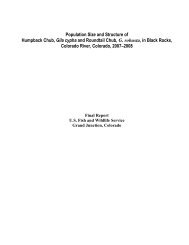K. R. Bestgen, K. A. Zelasko, and G. C. White. Monitoring ...
K. R. Bestgen, K. A. Zelasko, and G. C. White. Monitoring ...
K. R. Bestgen, K. A. Zelasko, and G. C. White. Monitoring ...
You also want an ePaper? Increase the reach of your titles
YUMPU automatically turns print PDFs into web optimized ePapers that Google loves.
numbers during the reproductive season. This was particularly evident in the middle Green<br />
River, when the few remaining wild razorback suckers present in the late 1990’s could typically<br />
be found only during spring on or near shallow spawning areas or in or near off-channel habitats<br />
(<strong>Bestgen</strong> 1990; <strong>Bestgen</strong> et al. 2002). Those seasonal patterns may indicate that fish in other<br />
seasons are spread out, difficult to detect because of the habitat they use (e.g., water depths that<br />
do not allow efficient electrofishing), or both. Perhaps for those reasons, adult life stage<br />
razorback suckers have sometimes been described as difficult to sample. Support for relative<br />
difficulty of sampling comes from relatively low probabilities of capture for 1 st year <strong>and</strong><br />
subsequent life stage fish (<strong>Zelasko</strong> 2008; <strong>Zelasko</strong> et al. 2009; 2010; 2011), which were generally<br />
< 0.04 (median = 0.0385, 0.002–0.128). Razorback suckers in the San Juan River had higher<br />
capture probabilities (<strong>Bestgen</strong> et al. 2009), which may be indicative of the prevailing shallow<br />
habitat through much of that river, <strong>and</strong> depth-related differences in capture probabilities.<br />
Life history parameter estimation based on tag-recapture data was useful to assess<br />
survival of stocked razorback suckers, <strong>and</strong> to refine stocking goals <strong>and</strong> procedures. Those<br />
studies found survival of fish recaptured in a relatively short time after stocking (9–12 months)<br />
was very low <strong>and</strong> was size-dependent, but after that survival was much higher <strong>and</strong> rates were<br />
similar to that for wild fish (<strong>Bestgen</strong> et al. 2002; <strong>Zelasko</strong> et al. 2010). A main conclusion of<br />
those analyses that were especially relevant for monitoring was that probabilities of capture (p’s)<br />
were quite low, <strong>and</strong> much lower than was typically found for species like Colorado pikeminnow<br />
or razorback suckers in different systems (<strong>Bestgen</strong> et al. 2007, <strong>Zelasko</strong> et al. 2009, <strong>Bestgen</strong> et al.<br />
2009) even though data were derived from some of the same sampling programs. For example,<br />
Colorado pikeminnow <strong>and</strong> many razorback sucker captures were from the same multi-pass,<br />
multi-year (e.g., robust-design, Pollock 1982; Pollock et al. 1990) sampling programs in the<br />
Green <strong>and</strong> Colorado rivers. <strong>Zelasko</strong> et al. (2010) identified low p’s as a concern <strong>and</strong> we excerpt<br />
that here:<br />
“Ultimately, increasing capture probability must become a priority if more<br />
precise parameter estimation is desired. In mark-recapture studies, one aims to<br />
capture the most individuals from a released cohort on the first occasion after<br />
initial marking (stocking), which equates to high recapture probability.<br />
Although this study improved on that aim compared to the previous analysis,<br />
data were still collected from a variety of sampling programs where effort was<br />
sometimes low after stocking substantial numbers of fish, <strong>and</strong> very few efforts<br />
specifically targeted stocked razorback suckers. In contrast, species-specific,<br />
Colorado pikeminnow abundance estimate sampling produced recapture<br />
probabilities ranging from 0.01 to 0.20 in the Green River subbasin, 2000–2003<br />
24




